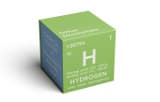
Tritium standards (H-3)
Tritium, symbol H-3 or Ta, is a radioactive isotope of hydrogen that emits beta electrons. Its core, called Triton 2, consists of a proton and two neutrons. Tritium is three times heavier than ordinary hydrogen, the nucleus of which is reduced to one proton, and one and a half times heavier than deuterium, another isotope of hydrogen, the nucleus of which consists of a proton and Of a neutron.
Tritium is relatively rare in its natural state (about 1 atom of tritium per 1018 atom of hydrogen), it is produced in very small quantities in the atmosphere by cosmic radiation. Unlike protium (H-1) and deuterium (H-2), other isotopes of hydrogen, tritium is a radioactive isotope. The period of this unstable nucleus is 12.3 years.
Because of its relatively short period, tritium is generally considered a highly radioactive element. But the consequences of its radioactive character are happily alleviated by the characteristics of its disintegration. The average energy of the electron is exceptionally low: 5.7 keV to be compared with several hundreds of keV in general for the beta decays. In addition, tritium does not emit gamma rays.
In biology, tritium is used to mark hydrogen and study its metabolism. Tritium thus evaluated the life cycle of hydrogen in the human body between 6 and 9 days.
Search result : 24 product found
Refine your search :
RUOCE / IVD
- [3H] 24
- Radiochemicals 24
Cat#
Description
Cond.
Price Bef. VAT
‹
›

